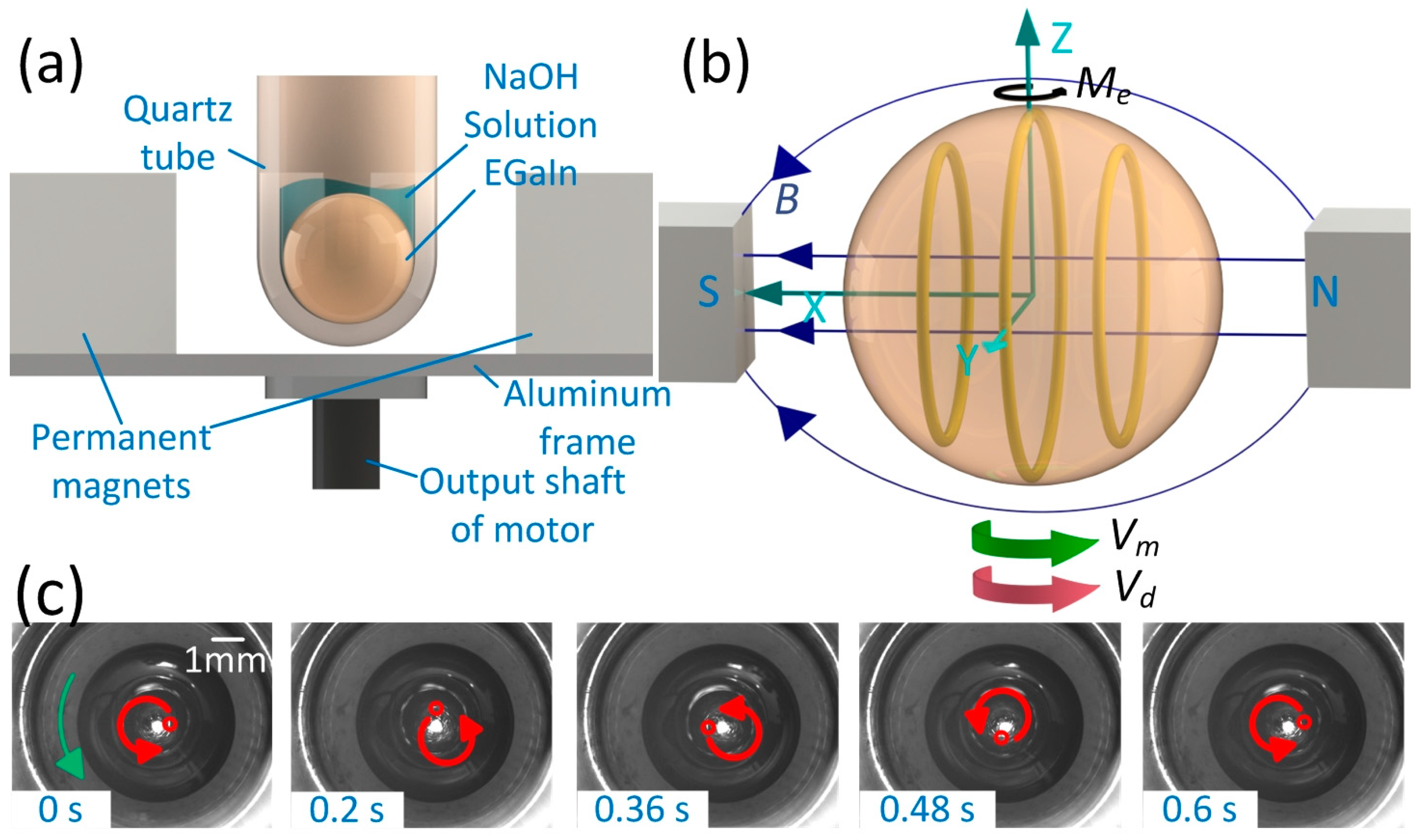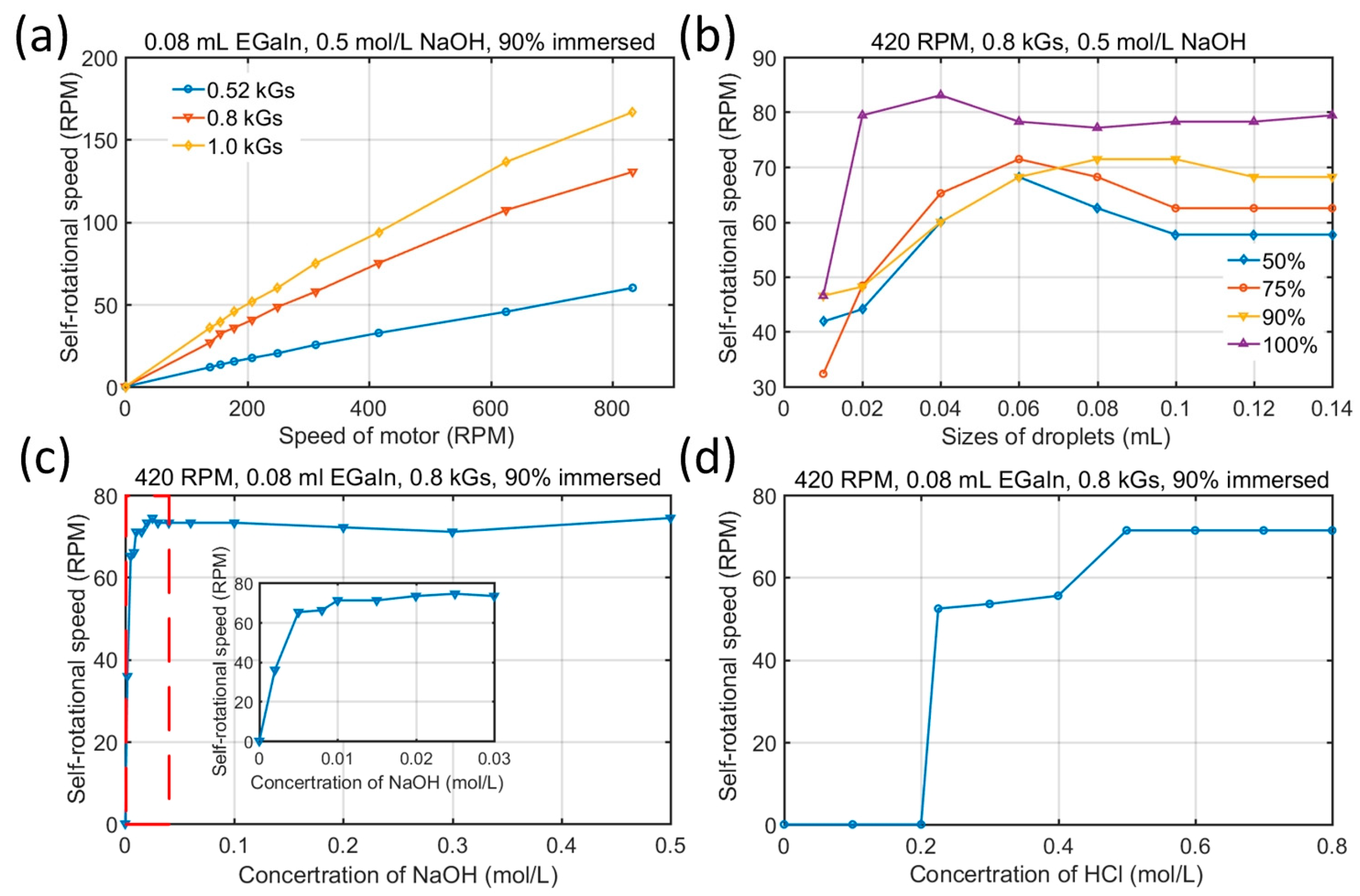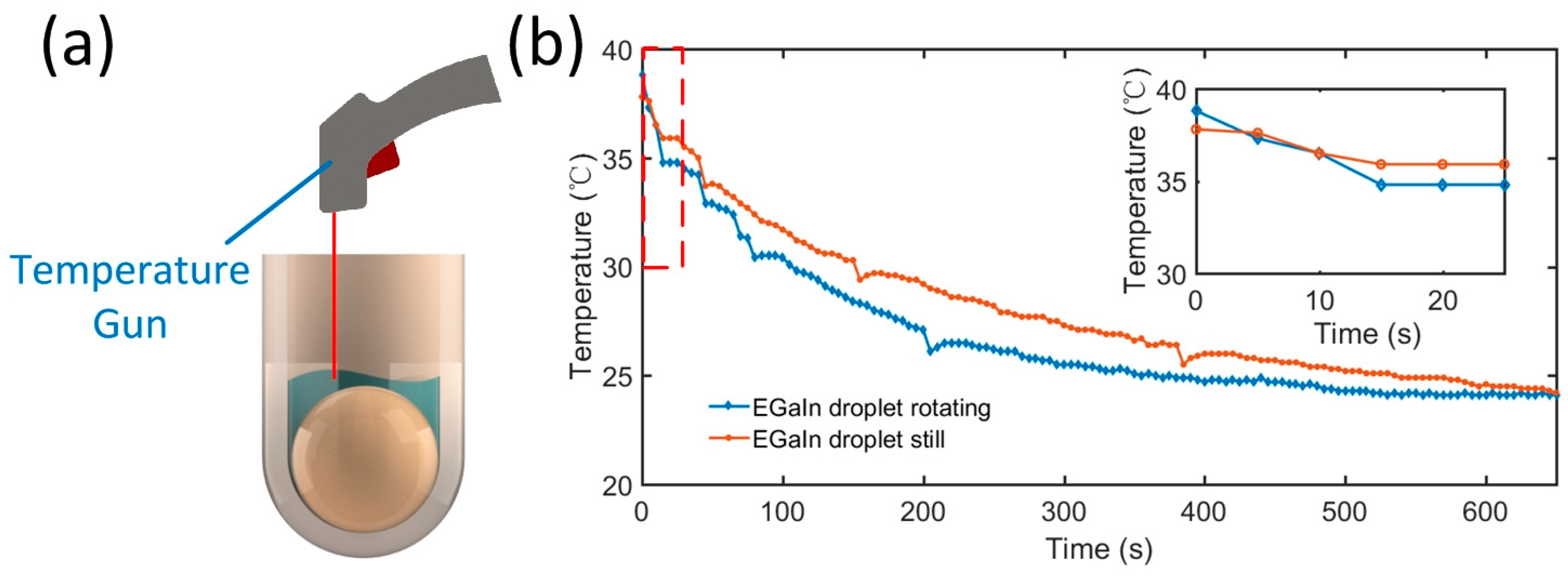Rotation of Liquid Metal Droplets Solely Driven by the Action of Magnetic Fields
Abstract
1. Introduction
2. Materials and Methods
3. Results and Discussions
4. Conclusions
Supplementary Materials
Author Contributions
Funding
Conflicts of Interest
References
- Dickey, M.D. Stretchable and Soft Electronics using Liquid Metals. Adv. Mater. 2017, 29, 1606425. [Google Scholar] [CrossRef]
- Tang, S.-Y.; Khoshmanesh, K.; Sivan, V.; Petersen, P.; O’Mullane, A.P.; Abbott, D.; Mitchell, A.; Kalantar-Zadeh, K. Liquid metal enabled pump. Proc. Natl. Acad. Sci. USA 2014, 111, 3304–3309. [Google Scholar] [CrossRef]
- Ladd, C.; So, J.-H.; Muth, J.; Dickey, M.D. 3D Printing of Free Standing Liquid Metal Microstructures. Adv. Mater. 2013, 25, 5081–5085. [Google Scholar] [CrossRef] [PubMed]
- Markvicka, E.J.; Bartlett, M.D.; Huang, X.; Majidi, C. An autonomously electrically self-healing liquid metal–elastomer composite for robust soft-matter robotics and electronics. Nat. Mater. 2018, 17, 618–624. [Google Scholar] [CrossRef]
- Reichel, K.S.; Lozada-Smith, N.; Joshipura, I.D.; Ma, J.; Shrestha, R.; Mendis, R.; Dickey, M.D.; Mittleman, D.M. Electrically reconfigurable terahertz signal processing devices using liquid metal components. Nat. Commun. 2018, 9, 4202. [Google Scholar] [CrossRef] [PubMed]
- Palleau, E.; Reece, S.; Desai, S.C.; Smith, M.E.; Dickey, M.D. Self-Healing Stretchable Wires for Reconfigurable Circuit Wiring and 3D Microfluidics. Adv. Mater. 2013, 25, 1589–1592. [Google Scholar] [CrossRef] [PubMed]
- Khoshmanesh, K.; Tang, S.-Y.; Zhu, J.Y.; Schaefer, S.; Mitchell, A.; Kalantar-Zadeh, K.; Dickey, M.D. Liquid metal enabled microfluidics. Lab Chip 2017, 17, 974–993. [Google Scholar] [CrossRef] [PubMed]
- Shao, C.Y.; Kawai, Y.; Esashi, M.; Ono, T. Electrostatic actuator probe with curved electrodes for time-of-flight scanning force microscopy. Rev. Sci. Instrum. 2010, 81, 083702. [Google Scholar] [CrossRef] [PubMed]
- Koo, H.J.; So, J.H.; Dickey, M.D.; Velev, O.D. Towards all-soft matter circuits: Prototypes of quasi-liquid devices with memristor characteristics. Adv. Mater. 2011, 23, 3559–3564. [Google Scholar] [CrossRef] [PubMed]
- Jeong, S.H.; Hagman, A.; Hjort, K.; Jobs, M.; Sundqvist, J.; Wu, Z. Liquid alloy printing of microfluidic stretchable electronics. Lab Chip 2012, 12, 4657–4664. [Google Scholar] [CrossRef] [PubMed]
- Tabatabai, A.; Fassler, A.; Usiak, C.; Majidi, C. Liquid-phase gallium-indium alloy electronics with microcontact printing. Langmuir 2013, 29, 6194–6200. [Google Scholar] [CrossRef]
- Liu, T.Y.; Sen, P.; Kim, C.J.C.J. Characterization of Nontoxic Liquid-Metal Alloy Galinstan for Applications in Microdevices. J. Microelectromech. Syst. 2012, 21, 443–450. [Google Scholar] [CrossRef]
- Dickey, M.D. Emerging applications of liquid metals featuring surface oxides. ACS Appl. Mater. Interfaces 2014, 6, 18369–18379. [Google Scholar] [CrossRef] [PubMed]
- Zhang, J.; Yao, Y.; Sheng, L.; Liu, J. Self-fueled biomimetic liquid metal mollusk. Adv. Mater. 2015, 27, 2648–2655. [Google Scholar] [CrossRef] [PubMed]
- Gough, R.C.; Dang, J.H.; Moorefield, M.R.; Zhang, G.B.; Hihara, L.H.; Shiroma, W.A.; Ohta, A.T. Self-Actuation of Liquid Metal via Redox Reaction. ACS Appl. Mater. Interfaces 2016, 8, 6–10. [Google Scholar] [CrossRef] [PubMed]
- Junghoon, L.; Chang-Jin, K. Surface-tension-driven microactuation based on continuous electrowetting. J. Microelectromech. Syst. 2000, 9, 171–180. [Google Scholar] [CrossRef]
- Khan, M.R.; Eaker, C.B.; Bowden, E.F.; Dickey, M.D. Giant and switchable surface activity of liquid metal via surface oxidation. Proc. Natl. Acad. Sci. USA 2014, 111, 14047–14051. [Google Scholar] [CrossRef] [PubMed]
- Tang, S.Y.; Sivan, V.; Khoshmanesh, K.; O’Mullane, A.P.; Tang, X.; Gol, B.; Eshtiaghi, N.; Lieder, F.; Petersen, P.; Mitchell, A.; et al. Electrochemically induced actuation of liquid metal marbles. Nanoscale 2013, 5, 5949–5957. [Google Scholar] [CrossRef] [PubMed]
- Krupenkin, T.; Taylor, J.A. Reverse electrowetting as a new approach to high-power energy harvesting. Nat. Commun. 2011, 2, 448. [Google Scholar] [CrossRef]
- Bartlett, M.D.; Fassler, A.; Kazem, N.; Markvicka, E.J.; Mandal, P.; Majidi, C. Stretchable, High-k Dielectric Elastomers through Liquid-Metal Inclusions. Adv. Mater. 2016, 28, 3726–3731. [Google Scholar] [CrossRef]
- Tang, S.Y.; Joshipura, I.D.; Lin, Y.; Kalantar-Zadeh, K.; Mitchell, A.; Khoshmanesh, K.; Dickey, M.D. Liquid-Metal Microdroplets Formed Dynamically with Electrical Control of Size and Rate. Adv. Mater. 2016, 28, 604–609. [Google Scholar] [CrossRef] [PubMed]
- Wu, J.; Tang, S.Y.; Fang, T.; Li, W.; Li, X.; Zhang, S. A Wheeled Robot Driven by a Liquid-Metal Droplet. Adv. Mater. 2018, e1805039. [Google Scholar] [CrossRef] [PubMed]
- Mohammed, M.; Sundaresan, R.; Dickey, M.D. Self-Running Liquid Metal Drops that Delaminate Metal Films at Record Velocities. ACS Appl. Mater. Interfaces 2015, 7, 23163–23171. [Google Scholar] [CrossRef] [PubMed]
- Tang, S.Y.; Sivan, V.; Petersen, P.; Zhang, W.; Morrison, P.D.; Kalantar-zadeh, K.; Mitchell, A.; Khoshmanesh, K. Liquid Metal Actuator for Inducing Chaotic Advection. Adv. Funct. Mater. 2014, 24, 5851–5858. [Google Scholar] [CrossRef]
- Tang, S.Y.; Lin, Y.; Joshipura, I.D.; Khoshmanesh, K.; Dickey, M.D. Steering liquid metal flow in microchannels using low voltages. Lab Chip 2015, 15, 3905–3911. [Google Scholar] [CrossRef] [PubMed]
- Wissman, J.; Dickey, M.D.; Majidi, C. Field-Controlled Electrical Switch with Liquid Metal. Adv. Sci. 2017, 4, 1700169. [Google Scholar] [CrossRef]
- Russell, L.; Wissman, J.; Majidi, C. Liquid metal actuator driven by electrochemical manipulation of surface tension. Appl. Phys. Lett. 2017, 111, 254101. [Google Scholar] [CrossRef]
- Kim, D.; Lee, J.B. Magnetic-field-induced Liquid Metal Droplet Manipulation. J. Korean Phys. Soc. 2015, 66, 282–286. [Google Scholar] [CrossRef]
- Tang, X.K.; Tang, S.Y.; Sivan, V.; Zhang, W.; Mitchell, A.; Kalantar-zadeh, K.; Khoshmanesh, K. Photochemically induced motion of liquid metal marbles. Appl. Phys. Lett. 2013, 103, 174104. [Google Scholar] [CrossRef]
- Wang, L.; Liu, J. Electromagnetic rotation of a liquid metal sphere or pool within a solution. Proc. R. Soc. A Math. Phys. Eng. Sci. 2015, 471, 20150177. [Google Scholar] [CrossRef]
- Chertkov, M.; Lebedev, V. Boundary Effects on Chaotic Advection-Diffusion Chemical Reactions. Phys. Rev. Lett. 2003, 90, 134501. [Google Scholar] [CrossRef] [PubMed]
- Priye, A.; Hassan, Y.A.; Ugaz, V.M. Microscale Chaotic Advection Enables Robust Convective DNA Replication. Anal. Chem. 2013, 85, 10536–10541. [Google Scholar] [CrossRef] [PubMed]
- Tohidi, A.; Hosseinalipour, S.M.; Taheri, P.; Nouri, N.M.; Mujumdar, A.S. Chaotic advection induced heat transfer enhancement in a chevron-type plate heat exchanger. Heat Mass Transfer 2013, 49, 1535–1548. [Google Scholar] [CrossRef]
- Lefevre, A.; Mota, J.P.B.; Rodrigo, A.J.S.; Saatdjian, E. Chaotic advection and heat transfer enhancement in Stokes flows. Int. J. Heat Fluid 2003, 24, 310–321. [Google Scholar] [CrossRef]
- Solomon, T.H.; Mezic, I. Uniform resonant chaotic mixing in fluid flows. Nature 2003, 425, 376–380. [Google Scholar] [CrossRef] [PubMed]
- Stroock, A.D.; Dertinger, S.K.W.; Ajdari, A.; Mezic, I.; Stone, H.A.; Whitesides, G.M. Chaotic mixer for microchannels. Science 2002, 295, 647–651. [Google Scholar] [CrossRef] [PubMed]
- Sundararajan, P.; Stroock, A.D. Transport Phenomena in Chaotic Laminar Flows. Chem. Biomol. Eng. 2012, 3, 473–496. [Google Scholar] [CrossRef] [PubMed]
- Shu, J.; Tang, S.Y.; Feng, Z.H.; Li, W.H.; Li, X.P.; Zhang, S.W. Unconventional locomotion of liquid metal droplets driven by magnetic fields. Soft Matter 2018, 14, 7113–7118. [Google Scholar] [CrossRef]
- Li, X.; Xie, J.; Tang, S.Y.; Xu, R.; Li, X.; Li, W.; Zhang, S. A Controllable Untethered Vehicle Driven by Electrically Actuated Liquid Metal Droplets. IEEE Trans. Ind. Inform. 2018. [Google Scholar] [CrossRef]
- Priede, J.; Gerbeth, G. Spin-up instability of electromagnetically levitated spherical bodies. IEEE. Trans. Magn. 2000, 36, 349–353. [Google Scholar] [CrossRef]
- Graf, H.; Lauer, U.A.; Schick, F. Eddy-current induction in extended metallic parts as a source of considerable torsional moment. J. Magn. Reson Imaging 2006, 23, 585–590. [Google Scholar] [CrossRef] [PubMed]
- Koo, C.; LeBlanc, B.E.; Kelley, M.; Fitzgerald, H.E.; Huff, G.H.; Han, A. Manipulating Liquid Metal Droplets in Microfluidic Channels With Minimized Skin Residues Toward Tunable RF Applications. J. Microelectromech. Syst. 2015, 24, 1069–1076. [Google Scholar] [CrossRef]
- Khan, M.R.; Trlica, C.; So, J.H.; Valeri, M.; Dickey, M.D. Influence of water on the interfacial behavior of gallium liquid metal alloys. ACS Appl. Mater. Interfaces 2014, 6, 22467–22473. [Google Scholar] [CrossRef] [PubMed]
- Dang, J.H.; Gough, R.C.; Morishita, A.M.; Ohta, A.T.; Shiroma, W.A. Liquid-metal frequency-reconfigurable slot antenna using air-bubble actuation. Electron. Lett. 2015, 51, 1630–1631. [Google Scholar] [CrossRef]
- Beinerts, T.; Bojarevičs, A.; Bucenieks, I.; Gelfgat, Y.; Kaldre, I. Use of permanent magnets in electromagnetic facilities for the treatment of aluminum alloys. Metall. Mater. Trans. B 2016, 47, 1626–1633. [Google Scholar] [CrossRef]
- Dzelme, V.; Jakovics, A.; Bucenieks, I. Numerical modelling of liquid metal electromagnetic pump with rotating permanent magnets. Mater. Sci. Eng. 2018, 424, 012046. [Google Scholar] [CrossRef]
- Zavabeti, A.; Ou, J.Z.; Carey, B.J.; Syed, N.; Orrell-Trigg, R.; Mayes, E.L.H.; Xu, C.L.; Kavehei, O.; O’Mullane, A.P.; Kaner, R.B.; et al. A liquid metal reaction environment for the room-temperature synthesis of atomically thin metal oxides. Science 2017, 358, 332–335. [Google Scholar] [CrossRef] [PubMed]




© 2019 by the authors. Licensee MDPI, Basel, Switzerland. This article is an open access article distributed under the terms and conditions of the Creative Commons Attribution (CC BY) license (http://creativecommons.org/licenses/by/4.0/).
Share and Cite
Shu, J.; Tang, S.-Y.; Zhao, S.; Feng, Z.; Chen, H.; Li, X.; Li, W.; Zhang, S. Rotation of Liquid Metal Droplets Solely Driven by the Action of Magnetic Fields. Appl. Sci. 2019, 9, 1421. https://doi.org/10.3390/app9071421
Shu J, Tang S-Y, Zhao S, Feng Z, Chen H, Li X, Li W, Zhang S. Rotation of Liquid Metal Droplets Solely Driven by the Action of Magnetic Fields. Applied Sciences. 2019; 9(7):1421. https://doi.org/10.3390/app9071421
Chicago/Turabian StyleShu, Jian, Shi-Yang Tang, Sizepeng Zhao, Zhihua Feng, Haoyao Chen, Xiangpeng Li, Weihua Li, and Shiwu Zhang. 2019. "Rotation of Liquid Metal Droplets Solely Driven by the Action of Magnetic Fields" Applied Sciences 9, no. 7: 1421. https://doi.org/10.3390/app9071421
APA StyleShu, J., Tang, S.-Y., Zhao, S., Feng, Z., Chen, H., Li, X., Li, W., & Zhang, S. (2019). Rotation of Liquid Metal Droplets Solely Driven by the Action of Magnetic Fields. Applied Sciences, 9(7), 1421. https://doi.org/10.3390/app9071421





